Electronic Variable Optical Attenuators, Voltage Controlled & PM Fiber Coupled
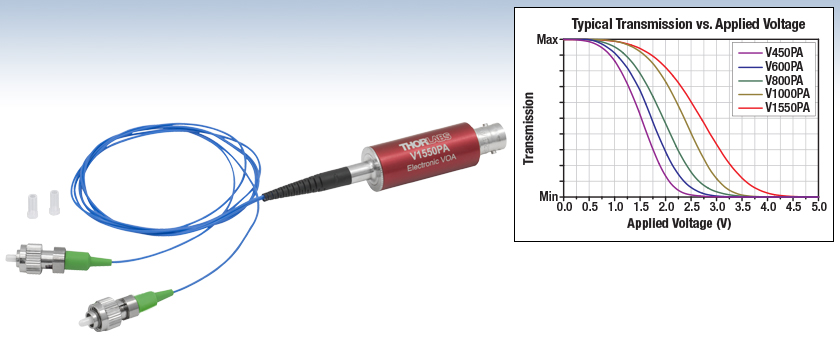
- MEMS-Based Control of Optical Power in PM Fiber
- Five Models Cover Wavelengths from 488 nm to 1610 nm
- Optical Attenuation up to >30 dB or >25 dB
- Modulation up to 1 kHz
V1550PA
Electronic VOA, FC/APC
(1450 to 1610 nm Model)
Typical Transmission as a Function of Applied Voltage

Please Wait
| Fiber Optic Attenuator Selection Guide | |
|---|---|
| SM |
Tabletop EVOAs with Power Lock |
| Digital VOAs | |
| Electronic VOAs for System Integration | |
| Manually Variable Attenuators | |
| Fixed-Value Attenuators | |
| PM |
Digital VOAs |
| Electronic VOAs for System Integration | |
| Manually Variable Attenuators | |
| MM | Manually Variable Attenuators |
| Fixed-Value Attenuators | |
PANDA PM Fiber Cross Section
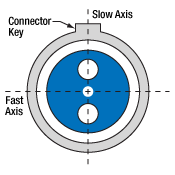
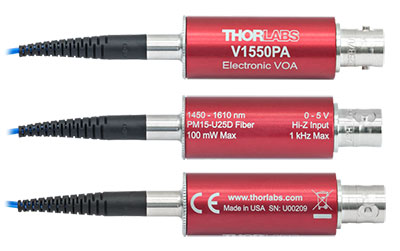
Click to Enlarge
Figure 1.1 A female BNC connector is located on one end of the barrel, and PM fiber leads with FC/APC connectors are integrated into the opposite end. Each barrel is engraved with the shown information for convenience.
Features
- MEMS-Based Device Provides Attenuation up to >30 dB or >25 dB
- Single Mode PM Operation over Five Wavelength Ranges
- 488 to 635 nm
- 620 to 850 nm
- 770 to 1100 nm
- 970 to 1550 nm
- 1450 to 1610 nm
- Control Optical Power by Applying 0 to 5 V Signal
- Maximum Optical Input Power up to 100 mW, Depending on Model
- Modulation up to 1 kHz
- Input is Protected from Electrostatic Discharge (ESD)
Thorlabs' Fiber-Coupled Electronic Variable Optical Attenuators (VOAs) are microelectromechanical system (MEMS) based devices that provide attenuation up to >30 dB or >25 dB, depending on the model, and a polarization extinction ratio (PER) of >13 dB. They use PANDA polarization-maintaining (PM) fiber with 2.0 mm narrow key FC/APC connectors with the key aligned to the slow axis of the fiber. Driving voltages of 0 to 5 V control optical transmission, which decreases with applied voltage. These high-speed VOAs support modulation up to 1 kHz. Protection diodes integrated into the design limit the input voltage to protect the VOA from ESD, as well as from other over-voltage and under-voltage events.
A plot of the typical relationship between the applied voltage and the optical transmission for each electronic VOA model is included in the Specs tab. Most voltage sources, including power supplies, function generators, and digital-to-analog converters (DACs), can be used to control these electronic VOAs. Use a BNC cable (not included) to connect the electronic VOA to the voltage source. The MEMS VOA is an electrostatic device that inherently requires no current. However, the protection circuitry can draw up to 100 µA for applied voltages of 5 V.
Either of the unit's 0.5 m long fiber leads can be used as the input, as performance is similar in both directions. However, you may find that one of the connectors provides a lower loss connection in your set-up due to the random nature of core alignment. As shown in Figure 1.1, the barrel of each electronic VOA is etched, for convenience, with information such as the operating wavelength range, maximum optical input power, maximum modulation bandwidth, and driving voltage range. These VOAs are designed for use with polarization-maintaining optical fiber that is single mode within the operating range. Please see the Specs tab for information on the polarization-maintaining fiber integrated into each model.
We also offer non-polarization maintaining single mode fiber versions of these electronic VOAs for system integration with either FC/PC or FC/APC connectors.
Fiber Core Alignment
Note that the minimum attenuation for these devices depends on excellent core-to-core alignment when the connectors are mated. This is even more crucial for shorter wavelength VOAs with smaller fiber core diameters. If they are not perfectly aligned, the insertion loss can easily go up many decibels above the specification. Since we cannot control the fibers that are used to connect to these devices, we test the devices for minimum attenuation by using a setup that actively aligns the cores of the fibers and minimizes the connector loss. From this, we obtain the minimum attenuation possible for each device. Unless the user also does the same, or better yet, fusion splices the fibers, they may not achieve the specified minimum attenuation.
Fiber Cleanliness
Fibers with smaller core diameters (<5 μm) must be kept extremely clean because the presence of material at fiber-fiber interfaces, combined with the high optical power density, can lead to significant optical damage. This is especially true at short wavelengths where the photon energy is also high. If care is not taken, the end of the fiber at the FC/PC or FC/APC connector can sustain damage that will reduce the coupling efficiency or possibly even prevent coupling altogether. This type of damage usually requires re-polishing or replacement of the connector. Depending on the specific conditions, this can even happen at average power levels less than 10 mW. Additional caution should be taken with pulsed lasers, since the peak power can be much higher than the average power. Please make sure the fiber ends are kept as clean as possible and cleaned every time a connection is made.
Maximum Optical Input Power
Due to its small fiber core diameter, as well as the high photon energies for light in the 488 nm to 600 nm range, the damage threshold for the V450PA attenuator is lower than for our other models. To avoid damage to the exposed fiber end faces and internal components, the optical input power should never exceed 20 mW, instead of the 100 mW maximum for all other attenuators sold on this page. If you observe decreased transmission or visible damage to the fiber core at the connector faces, re-polishing or replacing the connectors may restore performance if no internal damage has occurred.
| Item # | V450PA | V600PA | V800PA | V1000PA | V1550PA | |
|---|---|---|---|---|---|---|
| Wavelength Range | 488 to 635 nma | 620 to 850 nm | 770 to 1100 nm | 970 to 1550 nm | 1450 to 1610 nm | |
| Attenuationb | Max | >30 dB | >25 dB | |||
| Min | 3.0 dB | 2.5 dB | 2.0 dB | 1.5 dB | ||
| Optical Input Power (Max) | 20 mWc | 100 mW | ||||
| Optical Return Loss | >30 dB | |||||
| Polarization Extinction Ratio (PER) | >13 dB | >14 dB | >16 dB | |||
| Fiber Connectors | ||||||
| Optical Fiber Specificationse | ||||||
| Device Fiber Typef | PM460-HP | PM630-HP | PM780-HP | PM980-XP | Corning P15-U25D | |
| Mode Field Diameter | 3.3 ± 0.5 µm @ 515 nm |
4.5 ± 0.5 µm @ 630 nm |
5.3 ± 1.0 µm @ 850 nm |
6.6 ± 0.5 µm @ 980 nm |
10.5 ± 0.5 µm @ 1550 nm |
|
| Beat Length | 1.4 mm @ 488 nm | 1.8 mm @ 630 nm | 2.4 mm @ 850 nm | ≤2.7 mm @ 980 nm | 3.0 mm to 5.0 mm @ 1550 nm |
|
| Modulation Signal Input | ||||||
| Input Voltage | 0 to 5 V (Absolute Max: 10 V, 5 mA) | |||||
| Input Impedance | High-Z | |||||
| Bandwidth | DC to 1 kHz | |||||
| Input Voltage Connector | Female BNC | |||||
| Physical Specifications | ||||||
| Dimensions |
Diameter: 15.7 mm (0.62") |
|||||
| Operating Temperature Range | 0 °C to 40 °C | |||||
| Storage Temperature Range | -20 °C to 70 °C | |||||
| Relative Humidity | 5% to 85% (Non-Condensing) | |||||
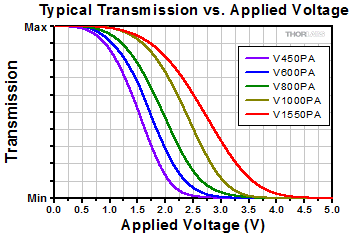
Click to Enlarge
Figure 2.1 Typical Optical Transmission as a Function of Applied Voltage (Test Wavelengths: 520 nm for V450PA; 635 nm for V600PA;
850 nm for V800PA; 1060 nm for V1000PA;
and 1550 nm for V1550PA)
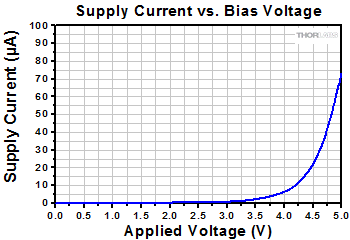
Click to Enlarge
Figure 2.2 The supply current required to drive the electronic VOA over the 0 to 5 V operating range is plotted here.

Click for Details
Figure 2.3 Mechanical Drawing of the Fiber-Coupled VOA Package

Adam Knapp
Ultrafast Optoelectronics
General Manager
Custom and OEM Options
When your application requirements are not met by our range of catalog products or their variety of user-configurable features, please contact me to discuss how we may serve your custom or OEM needs.
Request a Demo Unit
Explore the benefits of using a Thorlabs high-speed instrument in your setup and under your test conditions with a demo unit. Contact me for details.
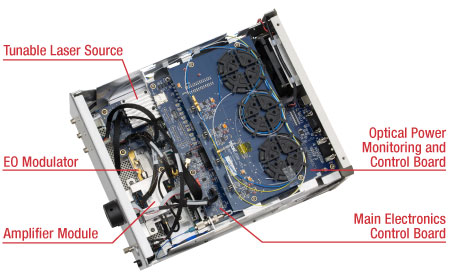
Click to Enlarge
Figure 162A The MX40B Digital Reference Transmitter
Design, Manufacturing, and Testing Capabilities
Thorlabs' Ultrafast Optoelectronics Team designs, develops, and manufactures high-speed components and instrumentation for a variety of photonics applications having frequency responses up to 110 GHz. Our extensive experience in high-speed photonics is supported by core expertise in RF/microwave design, optics, fiber optics, optomechanical design, and mixed-signal electronics. As a division of Thorlabs, a company with deep vertical integration and a portfolio of over 20,000 products, we are able to provide and support a wide selection of equipment and continually expand our offerings.
Our catalog and custom products include a range of integrated fiber-optic transmitters, modulator drivers and controllers, detectors, receivers, pulsed lasers, variable optical attenuators, and a variety of accessories. Beyond these products, we welcome opportunities to design and produce custom and OEM products that fall within our range of capabilities and expertise. Some of our key capabilities are:
- Detector and Receiver Design, to 70 GHz
- Fiber-Optic Transmitter Design, to 110 GHz
- RF & Microwave Design and Simulation
- Design of Fiber-Optic and Photonics Sub-Assemblies
- High-Speed Testing, to 110 GHz
- Micro-Assembly and Wire Bonding
- Hermetic Sealing of Microwave Modules
- Fiber Splicing of Assemblies
- Custom Laser Engraving
- Qualification Testing
Overview of Custom and Catalog Products
Our catalog product line includes a range of integrated fiber-optic transmitters, modulator drivers and controllers, detectors, pulsed lasers, and accessories. In addition to these, we offer related items, such as receivers and customized catalog products. The following sections give an overview of our spectrum of custom and catalog products, from fully integrated instruments to component-level modules.
Fiber-Optic Instruments
To meet a range of requirements, our fiber-optic instruments span a variety integration levels. Each complete transmitter includes a tunable laser, a modulator with driver amplifier and bias controller, full control of optical output power, and an intuitive touchscreen interface. The tunable lasers, modulator drivers, and modulator bias controllers are also available separately. These instruments have full remote control capability and can be addressed using serial commands sent from a PC.
- Fiber-Optic Transmitters, to 110 GHz
- Linear and Digital Transmitters
- Electrical-to-Optical Converters, to 110 GHz
- Modulator Drivers
- Modulator Bias Controllers
- C- and L-Band Tunable Lasers
Customization options include internal laser sources, operating wavelength ranges, optical fiber types, and amplifier types.
Fiber-Optic Components
Our component-level, custom and catalog fiber-optic products take advantage of our module design and hermetic sealing capability. Products include detectors with frequency responses up to 50 GHz, and we also specialize in developing fiber-optic receivers, operating up to and beyond 40 GHz, for instrumentation markets. Closely related products include our amplifier modules, which we offer upon request, variable optical attenuators, microwave cables, and cable accessories.
- Hermetically-Sealed Detectors, to 50 GHz
- Fiber-Optic Receivers, to 40 GHz
- Amplifier Modules
- Electronic Variable Optical Attenuators
- Microwave Cables and Accessories
Customization options include single mode and multimode optical fiber options, where applicable, and detectors optimized for time or frequency domain operation.
Free-Space Instruments
Our free-space instruments include detectors with frequency responses around 1 GHz and pulsed lasers. Our pulsed lasers generate variable-width, nanosecond-duration pulses, and a range of models with different wavelengths and optical output powers are offered. User-adjustable repetition rates and trigger in/out signals provide additional flexibility, and electronic delay-line products enable experimental synchronization of multiple lasers. We can also adapt our pulsed laser catalog offerings to provide gain-switching capability for the generation of pulses in the 100 ps range.
- Pulsed Lasers with Fixed 10 ns Pulse Duration
- Pulsed Lasers with Variable Pulse Width and Repetition Rates
- Electronic Delay Units to Synchronize NPL Series Pulsed Lasers
- Amplified Detectors
Customization options for the pulsed lasers include emission wavelength, optical output powers, and sub-nanosecond pulse widths.
| Posted Comments: | |
Takemasa Tamanuki
(posted 2024-04-08 20:22:34.11) I have found your description as “Device Fiber Type: P15-U25D” in the data sheet of V1550PA.
https://www.thorlabs.co.jp/drawings/2affc0ac5bba5295-5DF1C40F-D4AE-FAA2-B4687815D0D8F02F/V1550PA-SpecSheet.pdf
The “P15-U25D” is PM-Fiber?
I would appreciate if you could provide your kind feed-back.
Best regards,
T. Tamanuki jdelia
(posted 2024-04-11 01:26:58.0) Thank you for contacting Thorlabs. Yes, the P15-U25D is PM fiber. Peter Kortekaas
(posted 2022-04-08 11:34:36.86) Looks like the control bandwidth is 1kHz. Does that mean is typically takes 1ms to settle? I'm looking for something faster, around 600kHz. Do you have this technology? cdolbashian
(posted 2022-04-20 04:57:45.0) Thank you for reaching out to us Peter. After some discussing this with you via email, it seems like you are looking for something like a fiber-coupled amplitude modulator, or SOA to achieve the results you need for your specific application. Jong-Min Yoon
(posted 2020-12-28 19:46:01.2) Hello
I'm Jong-Min Yoon from Samsung Electronics
I'm curious about your electronic variable optical attenuator.
The detailed model we want is in below
V1550PA - Electronic Variable Optical Attenuator, PM Fiber, 1450 to 1610 nm, FC/APC
(https://www.thorlabs.com/thorproduct.cfm?partnumber=V1550PA)
We want to use this for attenuating power of our fiber delivered fs-laser
I wrote our laser's specification list in below
- Center wavelength : 1560 nm
- pulse duration : 60 fs
- Output power : 80 mW
- Repetition rate : 100 MHz
We are worrying about changing GVD(Group Velocity Dispersion) characteristics with different attenuations.
But there's no comments/graphs which explain the GVD characteristics.
Could you share us the above characteristics versus attenuation extents? (e.g. attnuation voltages)
Really appreciate for your help to us
Best regards
Jong-Min YLohia
(posted 2020-12-29 10:46:58.0) Hello, I see that you have already emailed us directly. We will follow up with you with more information. user
(posted 2020-11-20 15:14:49.07) Assuming 100% coupling at the connectors, what is the insertion loss of V600PA YLohia
(posted 2020-11-23 02:33:18.0) Please see the attenuation spec on the Specs tab -- the minimum attenuation (insertion loss) is specified as 2.5 dB for the V600PA. Hongzhou Ma
(posted 2020-11-20 15:09:25.663) Can I couple a 1W 639nm CW laser to V600PA? YLohia
(posted 2020-11-23 02:33:17.0) Hello, these are specified for 100 mW max input power, so we do not suggest putting in 1 Watt of power. Brent Bergner
(posted 2019-08-26 20:16:58.597) I am interested in the V600PA for an instrumetation application using a 2 mW HeNe. We also need a voltag controlled shutter so that the instrument can be operated as a Class 1 laser device. It would be perfect if we could use the VOA for this purpose, but it would need have minimum transmisstion at 0V (I believe DiCon calls this an "Opaque" attenuator type. Can this be done? What would be the lead? What would be the price? What would be the minumum order quantity. We need 3 for prototypes and 20 - 50 / year for production (starting Q2 2020). YLohia
(posted 2019-08-27 10:04:31.0) Hello, thank you for contacting Thorlabs. We can offer this in a “normally closed” configuration as a special item. Custom item quotes can be requested by emailing techsupport@thorlabs.com. We will reach out to you directly to discuss this further. matthias.weiss
(posted 2018-03-21 15:17:18.37) Are the plans for other wavelength ranges still up to date? A version that works in the range of 900-920nm would be very useful for us. YLohia
(posted 2018-04-03 10:03:25.0) Hello, thank you for your interest in our electronic VOAs. We are actually in the process of finalizing the release of this product line at various bands (including the range you're interested in) within the next two weeks. I will reach out to you directly to discuss the possibility of offering a pre-release "special" if you are interested. beaton
(posted 2018-01-23 10:22:27.003) Do you have any data on if this works at all at 1850 nm? I am using a pig-tailed VCSEL laser at 1850 nm with about 1 meter of P3-1550-FC fiber, APC connectors. tfrisch
(posted 2018-01-29 05:04:40.0) Hello, thank you for contacting Thorlabs. I'd expect a slightly higher insertion loss and bend loss at 1850nm, but I will reach out to you about a loan unit so that you can confirm if it is suitable for your application. hmcgui
(posted 2017-08-07 08:39:01.96) Any plans for a visible version? tfrisch
(posted 2017-08-16 03:07:16.0) Hello, thank you for contacting Thorlabs. We plan to release other wavelength ranges, and development priority will likely follow customer demand. I've posted your need in our internal engineering forum. |
 Products Home
Products Home














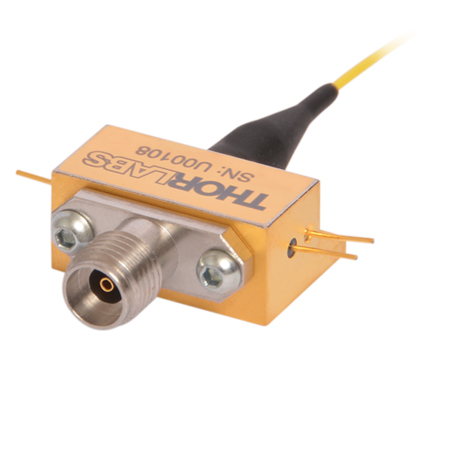

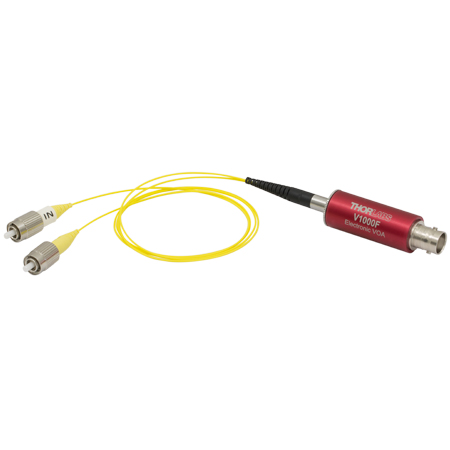
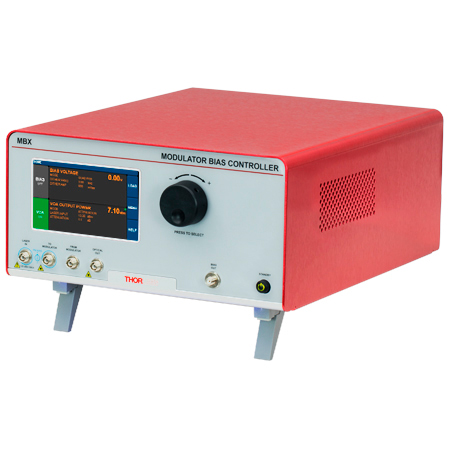
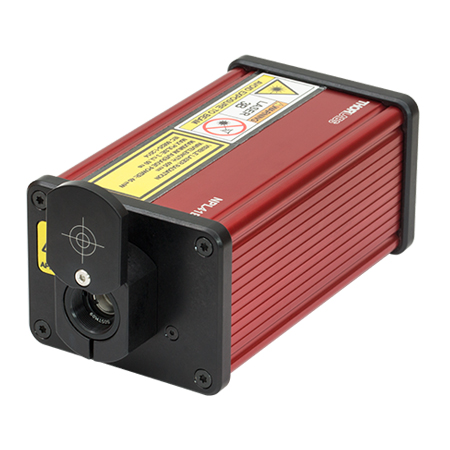
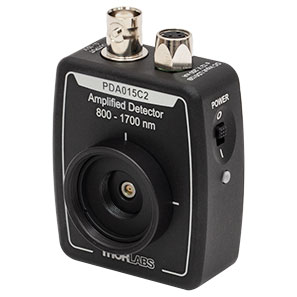
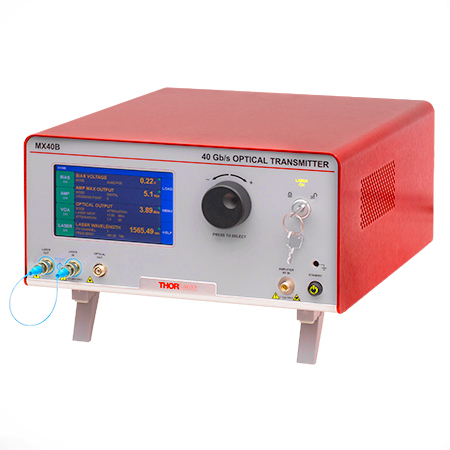
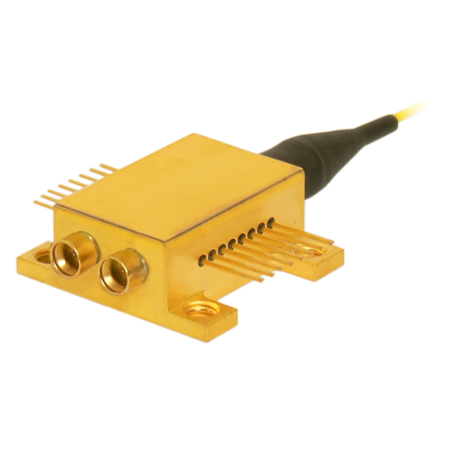
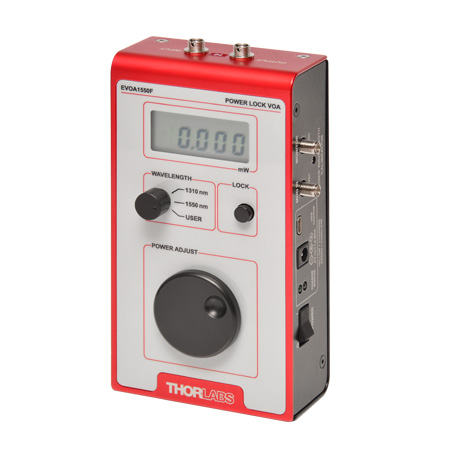
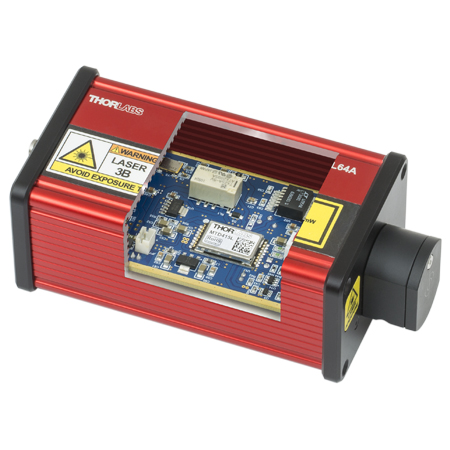
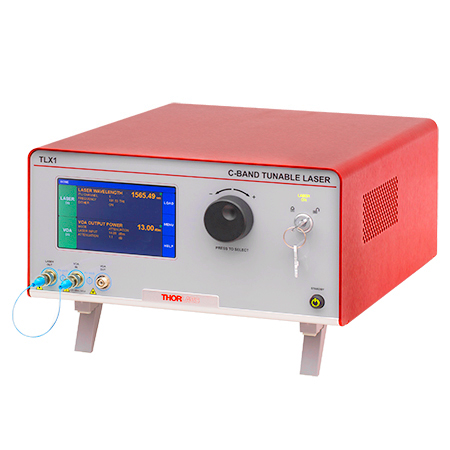

 PM Electronic VOAs for System Integration
PM Electronic VOAs for System Integration